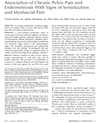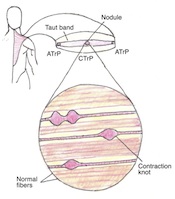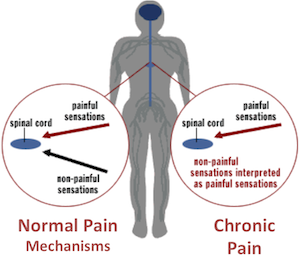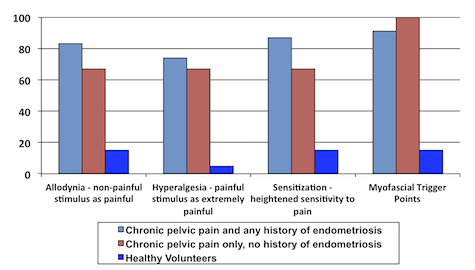Association of chronic pelvic pain and endometriosis with signs of sensitization and myofascial pain
NIH study published last week in Obstetrics and Gynecology suggests that a comprehensive nerve, muscle, and skeletal examination to identify pain sensitivity and myofascial trigger points better describes a pain experience and therefore may reveal potential sources of persistent pain in women with endometriosis [1].
 Endometriosis affects reproductive-aged women and is associated with chronic pelvic pain. Yet, neither the severity of pain nor the location of pain in women with endometriosis correlates with the location of endometriosis or the amount of disease [2].
Endometriosis affects reproductive-aged women and is associated with chronic pelvic pain. Yet, neither the severity of pain nor the location of pain in women with endometriosis correlates with the location of endometriosis or the amount of disease [2].
Chronic pain broadly affects an individual’s quality of life, and can result in depression, anxiety, and fatigue.
Dr Pamela Stratton, National Institutes of Health, USA
Says lead author, Dr Pamela Stratton of the NIH:
This simple, office-based examination is useful for evaluating pain because pain is poorly localised, of unpredictable intensity, and may manifest in structures unrelated to or remote from endometriosis lesions.
Our study is consistent with research on sensitisation and the association of myofascial trigger points with other pain syndromes.
Chronic pain and heightened sensitivity to pain
Chronic pain conditions are characterised by “sensitisation” which is defined as a heightened sensitivity to pain. This sensitivity is evident in a body region or throughout the body and can be diagnosed when a non-painful stimulus is perceived as painful or when a painful one is felt as extremely painful.

Trigger point complex
Myofascial (muscle) pain is characterised by “myofascial trigger points”. These trigger points are hard nodules within tight bands of muscle. When affected muscles are touched, they cause pain.
Sensitisation is reported in pain syndromes including endometriosis, migraine, fibromyalgia, painful bladder syndrome, irritable bowel syndrome, and other pain conditions. Abdominal wall myofascial trigger points are reported in those with endometriosis and in a rat endometriosis model in which pain symptoms consist of vaginal pain sensitivity and increased abdominal muscle activity [3,4].
Chronic pelvic pain and endometriosis
Dr Stratton and her team compared clinical signs of sensitisation and myofascial pain in women with chronic pelvic pain and healthy volunteers.

Pain mechanisms
After evaluation, all women reporting pain underwent laparoscopy to diagnose and treat endometriosis. Women with pain were then classified as having biopsy-proven endometriosis or not. Pain-free healthy participants had no endometriosis history or pain symptoms suggestive of endometriosis. Psychosocial and quality-of-life measures were also assessed.
The team theorised that women with chronic pelvic pain, regardless of endometriosis, would be more likely to have clinical signs of heightened pain sensitivity, muscle pain and impaired quality of life including depression and anxiety.
Results of the study
Eighteen women with current, biopsy-proven endometriosis were studied along with 11 with pain only and 20 healthy volunteers.
The prevalence of sensitisation as measured by regional sensitivity to pain was similar in both pain groups (83% and 82%) but was much lower in healthy volunteers (15%; p<.001).

Sensitisation and myofascial pain in women with chronic pelvic pain with or without a current diagnosis of biopsy-proven endometriosis and in healthy volunteers
Nearly all women with pain had myofascial trigger points (94 and 91%). Adjusting for study group, those with anxiety (odds ratio [OR] 1.05, 95% confidence interval [CI] 1.004–1.099, p=.031) and depression (OR 1.06, 95% CI 1.005–1.113, P=.032) were more likely to have sensitisation.
Pain patients with any history of endometriosis had the highest proportion of sensitisation compared with the others (87% compared with 67% for those with chronic pelvic pain who never had endometriosis and 15% in healthy volunteers; P<.001).

Sensitisation and myofascial pain in women with chronic pelvic pain with any history of endometriosis or never history of endometriosis and in healthy volunteers
Adjusting for any history of endometriosis, those with myofascial trigger points were most likely sensitised (OR 9.41, 95% CI 1.77–50.08, P=.009) [1].
Sensitisation and muscle pain were common in women with pain regardless of whether they had endometriosis at surgery. Those with any history of endometriosis were most likely to have sensitisation.
Current methods of classifying endometriosis-associated pain are inadequate
Our study suggests that anxiety and depression might contribute to the development of chronic pelvic pain. Multidimensional treatment strategies addressing psychosocial factors in addition to pain warrant study.
Traditional methods of classifying endometriosis-associated pain based on disease, duration, and anatomy are inadequate and should be replaced by a mechanism-based evaluation, as our study illustrates.
The development of successful treatment approaches to endometriosis-associated pain depends on targeting mechanisms and perpetuating factors of this common pain syndrome. Accordingly, clinicians and researchers should expand their focus beyond lesions to include a pain assessment.
Ultimately, this broader focus will enable a better understanding of how endometriosis affects the central nervous system compared with mechanisms underlying other chronic pain conditions.
said Dr Stratton.
References
- Stratton P, Khachikyan I, Sinaii N, Ortiz R, Shah J. Association of Chronic Pelvic Pain and Endometriosis With Signs of Sensitization and Myofascial Pain. Obstet Gynecol 2015;125(3):719-28.
- Vercellini P, Fedele L, Aimi G, Pietropaolo G, Consonni D, Crosignani PG. Association between endometriosis stage, lesion type, patient characteristics and severity of pelvic pain symptoms: a multivariate analysis of over 1000 patients. Hum Reprod 2007;22(1):266-71.
- Jarrell J. Myofascial dysfunction in the pelvis. Curr Pain Headache Rep 2004;8(6):452-6.
- Berkley KJ, McAllister SL, Accius BE, Winnard KP. Endometriosis-induced vaginal hyperalgesia in the rat: effect of estropause, ovariectomy, and estradiol replacement. Pain 2007;132 Suppl 1:S150-9.







